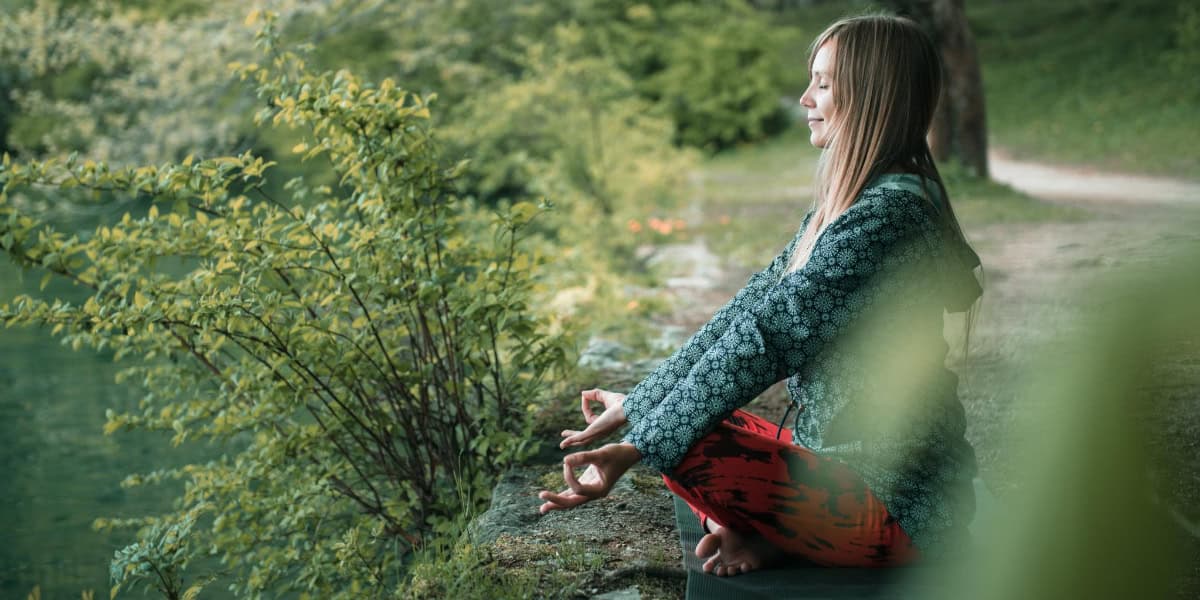Do you feel exhausted, overwhelmed and anxious? Do you want to relax and find inner peace? Mindfulness meditation could be the answer.
Mindfulness meditation is a practice that has been around for centuries, and its popularity has continued to grow in recent years. It is a simple and effective way to reduce stress, improve focus and concentration, and cultivate self-awareness.
In this article, we’ll look at what mindfulness meditation is and how to do it. We’ll discuss the basics of mindfulness meditation, the different types of mindfulness meditation, and tips for getting started. With the right mindset and the right tools, you can become a successful meditator and reap the many benefits of mindfulness meditation.
What Is Mindfulness Meditation?
Have you ever heard of mindfulness meditation? It’s a popular form of meditation that’s getting more attention and can help you live a more mindful life and reduce stress.
Mindfulness meditation is a practice that combines meditation techniques with mindfulness, or awareness, of the present moment.
It encourages an individual to become aware of their thoughts, feelings and emotions without judgment or criticism. Through mindfulness meditation, you can learn to observe your thoughts without getting caught up in them.
Mindfulness meditation is also known as Mindfulness-Based Stress Reduction (MBSR). This practice involves taking slow, deep breaths and focusing on the breath as it moves through the body.
It also includes body scans, where you focus your attention on different parts of the body and feel any tension or pain in those parts.
Mindfulness practices such as these can help you to become more aware of your body and how it responds to stress.
So, how can mindfulness meditation help you? That’s the next question we will explore.
Benefits Of Mindfulness Meditation
Mindfulness meditation can bring a wealth of benefits to your overall health and wellbeing. From increased concentration and a greater sense of inner peace, the practice of mindfulness meditation can have a powerful effect on your life.
Here are just a few of the ways mindfulness meditation can help you:
- Improved Mental Health: Mindfulness meditation practices can help to reduce anxiety, depression, and stress. It can also help to improve sleep, reduce negative thoughts, and increase overall happiness levels.
- Enhanced Concentration: Mindfulness meditation can help to sharpen your focus and improve concentration. Regular meditation exercise can help to keep your mind clear and reduce distractions, allowing you to better accomplish your goals.
- Stress Reduction: The practice of mindfulness can help to reduce stress levels and promote relaxation. It can also help to improve your overall sense of wellbeing and promote a sense of inner peace.
The benefits of mindfulness meditation extend far beyond the mental and emotional aspects. It can also help to improve physical health and reduce the risk of chronic diseases.
In addition, mindfulness-based stress reduction programs have been found to help with chronic pain, addiction, and more.
Mindfulness meditation is a powerful tool that can be used to bring a greater sense of balance and harmony into your life.
Whether you’re looking to reduce stress, increase focus, or just relax, deep breathing and mindfulness can help you bring a sense of calm into your life.
With so many potential benefits, it’s no wonder why mindfulness meditation is becoming increasingly popular.
Now that you have a better understanding of the potential benefits, it’s time to look at how to prepare for a successful meditation session.
Preparing To Meditate
Now that you know about the benefits of mindfulness meditation, it’s time to prepare for your practice. Mindfulness-based interventions and cognitive therapy are both important tools to consider, as they can help you develop the right techniques and strategies for success.
Transcendental meditation and other forms of meditation require you to have a certain level of comfort and concentration in order to achieve the desired results.
To do this, it’s important to make sure your feet are flat on the floor and that your body is relaxed. If you’re sitting in a chair, take a few moments to adjust until you find a comfortable position.
It’s worth noting that regular practice is key to getting the most out of your meditation, so make sure you set aside some time each day for your practice.
Once you’re all set up, it’s time to move on to establishing a routine. With the right attitude and approach, you’ll be sure to reap the rewards of mindfulness meditation in no time.
Establishing A Routine
Now that you have prepared to meditate, it is time to establish a routine. Creating a meditation program is a great way to start your formal meditation practice.
A routine allows you to easily fit meditating into your daily life and makes it a simple practice to integrate into your routine.
It is important to consider the different types of meditation and how they can be incorporated into your practice.
Additionally, behavioral therapy and other forms of therapy can be combined with meditation to provide a holistic approach to your mindfulness practice.
As you move forward, it is essential to find a comfortable position that works for you and your body.
Finding A Comfortable Position
The next step towards establishing a successful mindfulness meditation practice is finding a comfortable position for your meditation session.
Whether you prefer to sit in a chair or a meditation cushion, the goal is to sit for an extended period of time in a stable position. See: How to Create a Zen Meditation Room in Your Home: Ideas and Essentials
It’s important to ensure that your back is straight and that your arms are parallel with the ground.
Once you’ve found a comfortable seat, take a few moments to be mindful of your physical sensations:
- Do you feel any tightness in your muscles?
- Is your breath slow and steady or quick and shallow?
- Do you feel relaxed or tense?
Taking a few moments to check in with your body before you start your meditation session can help to prepare you for the journey ahead.
Now that you have taken a few moments to connect with your body and have found a comfortable position, you are ready to begin your basic mindfulness meditation.
Focusing On Your Breath
Now that you have found a comfortable position, it’s time to focus on your breath. This is an essential part of mindfulness meditation, as it helps to bring your attention to the present moment.
You can try a few different breathing exercises to get started, such as diaphragmatic breathing, or focusing on the sensation of breathing.
You can also experiment with different breathing rates and patterns, as well as meditation on the quality of your sleep.
By focusing on your breath, you can begin to observe the thoughts and feelings that arise within. This is a powerful tool for training your mind, as it can help you to gain insight and understanding into yourself.
As you become aware of these internal states, you can also begin to practice letting go of judgments.
Instead of labeling your thoughts as good or bad, or trying to change or control them, you can simply observe them with curiosity and acceptance.
Letting Go Of Judgments
After focusing on your breath and being present, the next step is to release any judgements.
It’s natural to get distracted and to feel the urge to judge yourself and your thoughts. This can be especially true when it comes to meditation, as many people use meditation apps, mindfulness based therapies, and other forms of meditation to seek out a deeper spiritual understanding.
To help you let go of judgments, consider practicing a form of meditation known as loving kindness meditation.
This type of meditation encourages you to cultivate compassion and kindness for oneself and for others. It’s a great way to cultivate a sense of inner peace and self-acceptance, and it can be especially helpful for those new to mindfulness based approaches.
It’s also important to remember that we are all learning and growing. If you find yourself judging yourself or your meditation practice, take a moment to step back and remember that this is a process. You don’t have to be perfect to be successful in your practice.
If you’re still having trouble with judgments, consider seeking out the help of a mindfulness teacher. They can help you to cultivate a deeper understanding of your practice and provide you with techniques to help you let go of judgments and stay present.
The last step is to stay present and notice your thoughts without getting attached to them.
Staying Present And Noticing Thoughts
With a letting go of judgment, comes the ability to stay present and notice thoughts. Mindfulness meditation, as described by Jon Kabat Zinn, is a form of meditation in which you observe your thoughts, feelings, and sensations without judgment.
This practice helps to cultivate a greater sense of peace and awareness in everyday life. It’s also a great way to learn how to deal with stress and anxiety.
As you sit in meditation, it can almost feel like you are standing at the edge of a river. Every thought that comes to your mind is like a leaf floating downstream.
You don’t have to hold onto any of these thoughts or follow them, you can simply observe them as they pass by. This can be a powerful exercise in building awareness of yourself and your environment.
This type of meditation can also help to cultivate the relaxation response, which is the body’s natural way of responding to stress.
By practicing mindfulness meditation, you can learn how to control your attention, rather than letting your attention control you. This can be a great way to cultivate a sense of peace and relaxation in your everyday life.
Controlling Your Attention
Taking control of your attention is a key part of mindfulness meditation. The idea of meditation is to be aware of the present moment without judgment, and so it’s important to not get distracted by the feelings and thoughts that come up.
Staying present means that you can observe your thoughts and feelings without attaching to them or getting pulled away.
One way to stay present and control your attention is to practice walking meditation. This involves slowly and consciously walking around a designated space and focusing on the movements of your body as you do so.
This helps to keep your thoughts and feelings in the background, so you can stay focused on the present moment.
Another way to stay present and control your attention is to practice meditation for sleep. This involves focusing on the rhythm of your breath and counting your breaths until you drift off to sleep. This helps to keep your mind from wandering, so you can focused on the present moment.
Meditation can take many forms, and all of them can provide a great benefit to your mental and physical health. From walking meditation to meditation for sleep, there are many different ways to practice mindfulness.
By controlling your attention and staying present, you can experience the full benefits of meditation and gain a greater understanding of your thoughts and feelings.
TIP: Don’t be discouraged if you have trouble controlling your attention at first. With time and practice, you can learn to stay present and observe your thoughts and feelings without getting pulled away.
Observing Body Sensations And Emotions
Now that you’ve gained a bit of control over your attention, it’s time to take things a step further and observe bodily sensations and emotions.
In mindfulness meditation, it is important to pay attention to the physical sensations of the body and the emotions that arise during our everyday activities. This can be done while walking, while sitting, or during other meditative practices.
By focusing on the body and the feelings that arise, you can start to develop an awareness of how your body responds in certain situations.
You may notice a tightness in your chest, a lightness in your head, or an ache in your stomach – all of which are signals from your body that something is going on.
It’s important to be mindful of these sensations and to take note of the emotions that accompany them.
By becoming aware of our bodily sensations and emotions, we can start to understand how our body works and the ways in which we can bring balance and harmony back into our lives.
This can be done through mindful activities and meditative practices that help us become more deeply connected to the world around us.
From here, we can start to practice compassion and self-acceptance as we take in the sensations and emotions that arise in our daily lives.
These practices can help to bring peace and understanding to our lives, and can help us to create a sense of inner balance and harmony.
Practicing Compassion And Self-Acceptance
Once you’ve taken a few moments to observe your body sensations and emotions, the next step is to practice compassion and self-acceptance.
This is a key part of any mindfulness meditation session and its goal is to cultivate a greater sense of self-love and understanding. Here are four tips to help you on your journey to inner peace:
- Recognize markers of stress. As you become more aware of your body and mind, start to notice the markers of stress. Is your breath rate shallow? Are your muscles tense? Is your mind racing? By recognizing when these signs are present, you can take steps to reduce your stress levels.
- Take moments to breathe. During your mindfulness-based practices, take moments to take a few deep breaths. This can help to bring a sense of calm and relaxation to your meditation session.
- Implement the teachings of Kabat-Zinn. The teachings of Kabat-Zinn have been proven to reduce levels of stress and anxiety. This includes practicing mindfulness, as well as acceptance and compassion for oneself.
- Acknowledge your emotions. Acknowledge your emotions and accept them without judgment. This is a key part of self-acceptance and can help to reduce feelings of shame and guilt.
By practicing compassion and self-acceptance during your mindfulness meditation session, you can cultivate a greater sense of inner peace and self-love.
This is an important step in your journey to inner calm and understanding. Without further ado, let’s move on to the next part of our meditation journey – facing difficulties during meditation.
Facing Difficulties During Meditation
As you practice mindfulness meditation, you may find yourself facing some difficulties. It can be easy to become frustrated and to give up when this happens.
However, it’s important to remember the old adage, “the journey of a thousand miles begins with a single step”. It’s the same with meditation. Every difficulty you face is another step closer to your goal of greater understanding.
Meditation centers such as those developed by John Kabat-Zinn and Jon Kabat-Zinn have formal meditation practices that can be helpful for those starting out.
Scan meditation is one such practice that involves observing the sensations and feelings within your body and mind, without judgment or attachment.
This type of meditation can be particularly effective for those wanting to gain further insight into their psychological and emotional states.
No matter which type of meditation you choose, there will be some difficulties along the way. It’s important to stay focused and to remember that every obstacle you face is a step closer to understanding.
While it can be tempting to give up, it’s important to keep going and to trust the process. With dedication and perseverance, you will start to see the effectiveness of meditation in your own life.
Ending Your Meditation Practice
When it comes time to end your meditation practice, there are a few steps you’ll want to take. To wrap things up:
- Make a mental note of any insights or revelations you’ve had during the meditation.
- Take a moment to thank yourself for taking the time to meditate.
- Acknowledge the progress you’ve made, regardless of any difficulties you may have faced.
- Re-check in with the goal of your meditation and take note of any progress you’ve made towards achieving it.
- Use the benefits of mindfulness to carry you through the rest of your day.
You can also take a few moments to reflect on the Buddhist tradition of meditation. Consider the journey you’ve taken and the progress you’ve made in your practice. It can be helpful to take a moment to remember why you began meditating and appreciate the commitment you’ve made to yourself.
As you draw to a close, it’s time to commit to continuing your practice.
Staying Committed To A Regular Practice
The final key to success with your mindfulness meditation practice is staying committed to a regular practice.
This can be challenging at first, especially if you have chronic pain, post traumatic stress disorder, or any other illnesses that make it difficult to sit still.
However, with a bit of dedication, you can maintain a successful meditation practice that can help to alleviate physical, mental, and emotional symptoms.
See: How Long Does It Take To Form A Habit?
It’s important to find a type of meditation that works for you. Many of us are familiar with the Buddhist tradition of mindfulness meditation, but there are other forms of meditation that can be just as beneficial.
For example, John Kabat Zinn created the Mindfulness-Based Stress Reduction program to help people find relief from physical and emotional pain by using yoga and guided practice.
No matter which type of meditation you choose, you should strive to find a daily practice that works for your lifestyle. Take the time to be mindful of yourself and your environment. If you can commit to a regular practice, then you’ll be on your way to finding greater peace and balance in your life.
It can be helpful to have a teacher or guide to help you along your journey.
Working With A Teacher Or Guide
Mindfulness meditation is a practice that requires patience, commitment, and dedication in order to see results. While individual practice is essential, it can also be helpful to work with a teacher or guide who can provide more personalized guidance and instruction.
Here are some of the benefits of working with a mindfulness meditation teacher:
- Get personalized instructions: Working with a teacher can help to give you more personalized instructions and guidance in order to get the most out of your practice. They can provide feedback on your heart rate, relaxation techniques, and other areas to help you get the most out of your practice.
- Learn the science behind mindfulness: A teacher can help to explain the scientific aspects of mindfulness, such as how different types of stress can be caused by different things. This can help to make your practice more meaningful and effective.
- Discover new techniques and strategies: A teacher can help to introduce you to new techniques and strategies that you may not have known about before. This can help to give your practice a new level of depth.
- Get support and encouragement: Working with a teacher can help to provide much-needed support and encouragement when things get tough. Having a partner in your practice can help to keep you on track and motivated to keep going.
Having a teacher or guide to work with can be incredibly helpful for those who are looking to deepen their practice of mindfulness meditation.
Working with a teacher can provide personalized instruction, help to explain the science behind the practice, introduce new techniques and strategies, and provide much-needed support. All of these elements can help to make your practice more effective and meaningful.
Can Mindfulness Meditation Help in Encouraging Mindfulness in Everyday Life?
Mindfulness meditation can be an effective tool in encouraging mindfulness practices in everyday life. By training the mind to focus on the present moment, individuals can develop a greater awareness of their thoughts and actions, leading to a more mindful approach to daily activities.
Final Thoughts
Mindfulness meditation is an effective and powerful way to reduce stress and cultivate a sense of inner peace. It can help to bring clarity and focus to our minds and bodies. Mindfulness meditation can be practiced in many different ways and can be tailored to fit your individual needs.
By creating a regular practice, you can learn to stay present in the moment and experience life in an entirely new way. It’s also important to be mindful of how you’re feeling during your meditation and to choose a practice that is comfortable and enjoyable.
Mindfulness meditation can be a great way to reduce stress and find more balance in your life. With a consistent practice, you can learn to stay in tune with your inner self and cultivate a deeper sense of peace and wellbeing.




